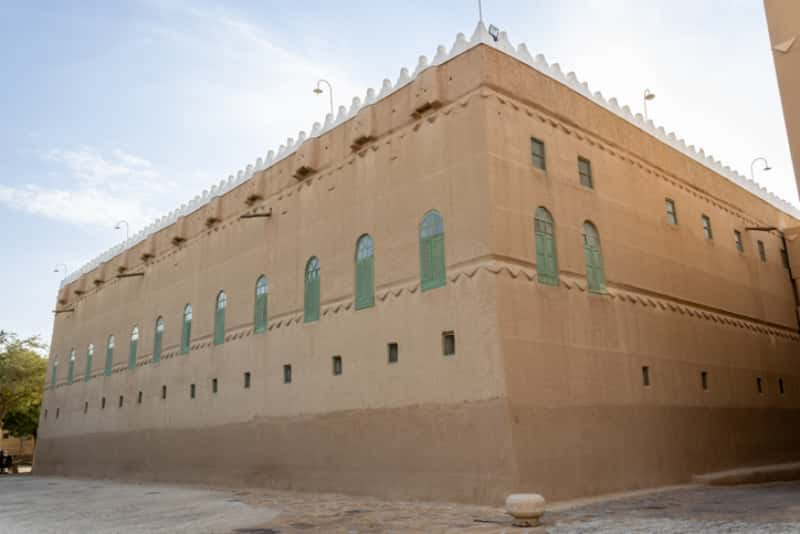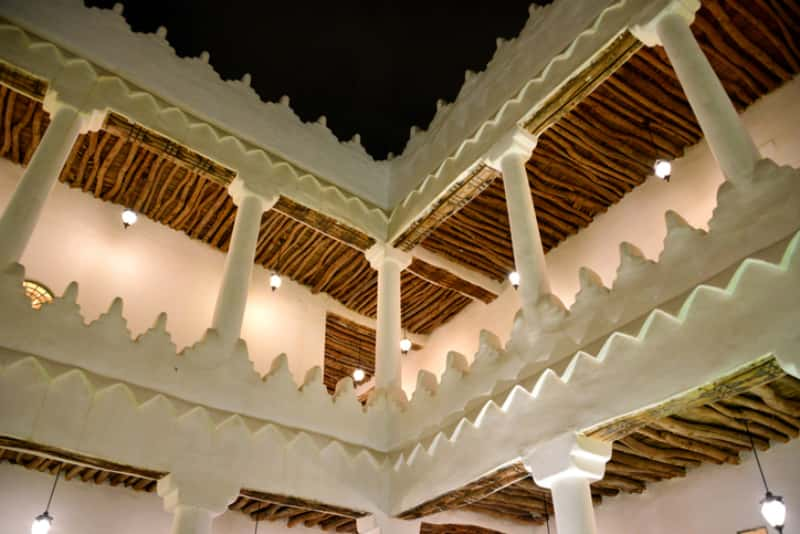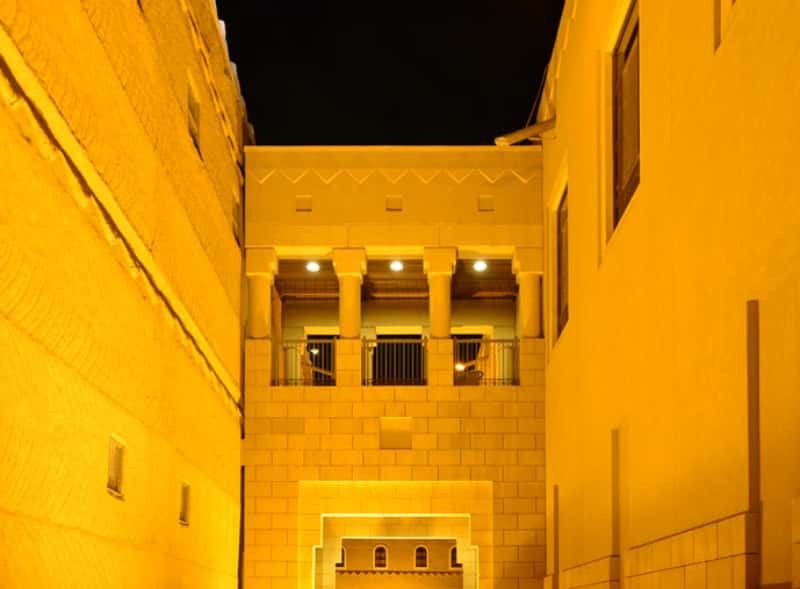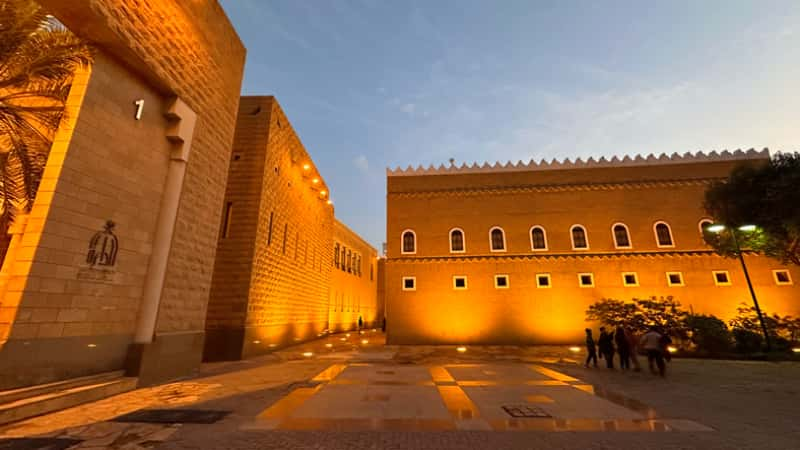Murabba Palace dominates the landscape of central Riyadh, a square-shaped historical monument extending across 10,000 square meters of Saudi Arabian soil. Constructed between 1936 and 1938, this regal structure became the official dwelling of King Abdulaziz until 1953, silently witnessing pivotal moments that forged the nation's identity. The palace derives its very name—Murabba—from its geometric perfection, with each side measuring precisely 400 meters.
Visitors to this architectural treasure encounter a living fragment of Saudi heritage. The palace showcases classic Najdi design principles through its 32 meticulously crafted rooms distributed across two levels. Local craftsmen fashioned the structure using indigenous materials—mud, stone, and palm fronds—creating an authentic representation of traditional Arabian building techniques. Most remarkable are the thick walls composed of sun-dried mud infused with straw, providing natural temperature regulation against the harsh desert climate.
The palace has evolved beyond its original purpose, now serving as a museum nestled within the expansive King Abdulaziz Historical Center. This cultural complex spans an impressive 440,000 square meters, primarily dedicated to lush garden spaces that contrast beautifully with the surrounding arid environment. The absence of admission fees removes financial barriers, allowing curious minds unrestricted access to this monument of national significance.
Murabba Palace emerged in 1936 during a transformative era in Saudi Arabian history. King Abdulaziz, architect of modern Saudi Arabia, commissioned this grand complex as Riyadh underwent swift urban expansion and demographic growth. The royal court increasingly recognized the limitations imposed by the ancient city walls, necessitating a bold step beyond these confines.
Workers broke ground for Murabba Palace in 1936 on a tract called "Murabba Al-Sufyan," land previously devoted to seasonal agricultural activities during periods of rainfall. King Abdulaziz personally oversaw the construction process, immersing himself in both design decisions and building supervision. Though partially habitable by 1938, craftsmen continued refining the structure until its full completion in 1945.
Situated merely 2 kilometers from old Riyadh, the palace embodied traditional Najdian architectural principles executed with extraordinary attention to craftsmanship. Royal planners strategically positioned the complex amidst natural features—gardens extending southward, Batha Valley stretching east, Wadi Abu Rafie flowing west, and gentle undulating hills rising to the north.
Murabba Palace stands as a monumental milestone marking Riyadh's first significant expansion in the 20th century. Following 36 years of residence within the constraints of Riyadh's ancient quarter at Qasr al-Hukm, King Abdulaziz relocated his household to this new dwelling in 1938.
The palace construction heralded technological advancement in Saudi society through three pioneering innovations: motorized transportation, electrical power generation, and modern plumbing systems with proper drainage. Engineers further connected this royal enclave to downtown Riyadh with a concrete roadway, itself a marvel of modern construction techniques.
Throughout its operational years, Murabba Palace functioned as the nucleus of Saudi governance. These walls witnessed countless historical pronouncements and royal edicts that sculpted Saudi Arabia's destiny. Several foundational institutions trace their origins to decisions made within these chambers:
The palace's Political Division evolved into what later became the Ministry of Foreign Affairs. This era saw additional pivotal developments, including the first Saudi currency issuance, commercial oil discovery, and the establishment of comprehensive administrative frameworks governing transportation, housing, employment, retirement benefits, and passport control.
Following King Abdulaziz's passing in 1953, his heir, King Saud, maintained Murabba Palace as a venue for official functions, notably presiding over the inaugural council of ministers gathering in March 1954.

The architectural tapestry of Murabba Palace embodies quintessential Najdi design principles that have characterized central Arabian constructions for centuries. This historical masterpiece displays an architectural philosophy exquisitely attuned to the unforgiving desert environment.
Murabba Palace stands as a testament to traditional Najdi architectural brilliance through its formidable structure and precise craftsmanship. Low-contour earth walls define its silhouette, adorned with distinctive triangular or rectangular apertures (furjat) and protective battlements (shurfat). Curious peepholes (tarma) project outward from the main façade, allowing discreet observation of approaching visitors. While exterior surfaces maintain deliberate simplicity with minimal embellishment, interior chambers reveal more intricate decorative elements befitting royal occupancy.
Desert wisdom guided material selection for the Murabba Palace. Builders employed straw-reinforced adobe for the substantial walls, creating a natural thermal barrier against scorching temperatures. Subtle engraved patterns adorned these functional walls, merging practicality with aesthetic sensibility. Stone foundations provided structural integrity, while ceilings showcased indigenous ingenuity—tamarisk trunks, local acacia timbers, and palm-leaf stalks bound meticulously together. Artisans enhanced these ceiling beams with vibrant geometric patterns in yellow, red, and black hues, transforming structural elements into visual masterpieces.
The palace rises as a perfect cube, housing exactly 32 chambers divided equally between two levels. Ground floor accommodations comprised 16 rooms dedicated to Royal Court functions, alongside auxiliary spaces for the king's attendants and household staff. The upper story contained two contrasting halls—an expansive chamber serving dual purposes as the king's summer sitting area and reception space for distinguished guests, complemented by a smaller western hall functioning as the king's winter majlis (council chamber).
The palace design radiates from a generous central courtyard. This fundamental element serves dual practical and cultural functions—facilitating natural air circulation while safeguarding privacy, a deeply cherished societal value. Throughout this geometrically perfect complex, interconnected covered passageways and thoughtfully arranged spaces mirror urban planning concepts that defined traditional Najdi communities for generations.

The year 1999 marked a pivotal turning point for Murabba Palace when the Saudi Commission for Tourism & Antiquities embarked on an ambitious restoration mission. Meticulous preservation efforts breathed new life into this historical jewel, culminating in its rebirth as a "living museum"—a term that perfectly captures its dynamic cultural role within the sprawling King Abdulaziz Historical Center.
Restoration specialists preserved the authentic character of Murabba while skillfully adapting its spaces for contemporary cultural purposes. Their careful documentation of Saudi history transformed the palace into an experiential gateway to the kingdom's rich heritage. The thoughtful development strategy maintained the distinctive qualities of the original structure while establishing it as a vibrant cultural nucleus that energizes surrounding neighborhoods. This architectural treasure now forms part of an integrated cultural district alongside the National Museum, King Abdulaziz Foundation for Research and Archives, and numerous other knowledge institutions.
Visitors exploring the ground floor discover meticulously preserved functional spaces—the vigilant guards' quarters and various storerooms for essential provisions like food, coffee, wood, and cooking implements. The upper level reveals elegant salons and waiting chambers once used to receive distinguished guests. Display cases throughout these historic rooms showcase an array of period garments and traditional craftsmanship. The royal car collection stands as perhaps the most captivating exhibit, featuring vehicles that once transported King Abdulaziz himself, including a magnificent green 1946 Rolls-Royce, presented as a diplomatic gift from British Prime Minister Winston Churchill. Weapon collections, ceremonial attire, and exquisite handicrafts from the era further enrich the visitor experience.
The King Abdulaziz Foundation created a physical connection between Murabba Palace and the Memorial Hall—a dedicated space safeguarding the founding monarch's historical legacy and personal possessions. This cultural repository houses three distinct collections:
The palace grounds encompass an extensive repository of photographic and written records. These meticulously organized collections chronicle the founding monarch's instrumental role in unifying disparate regions into a cohesive nation. The photography exhibition illuminates historical turning points and political achievements throughout King Abdulaziz's remarkable life. Modern technology enhances accessibility through virtual tour capabilities, allowing remote visitors to examine royal memorabilia and historical treasures through immersive 3D presentations accessible from anywhere across the globe.

Murabba Palace rewards visitors who arrive prepared. This guide offers essential details for maximizing your exploration of this historical treasure, from optimal visiting times to nearby comforts.
Murabba Palace maintains a regular schedule welcoming curious minds throughout the week. Saturday through Thursday, palace doors open during dual periods: morning hours from 9:00 AM to 12:00 PM and evening sessions from 5:00 PM to 8:00 PM. Friday visits occur exclusively during evening hours, 5:00 PM to 8:00 PM.
Palace administrators have removed financial barriers entirely—admission remains completely free. No tickets, no fees. This accessibility policy encourages exploration regardless of budget constraints. Most visitors discover that 2-3 hours provides sufficient time to absorb the palace's historical richness and architectural details.
October through April delivers the most comfortable climate for exploring Murabba Palace. Summer temperatures frequently climb to punishing heights, occasionally reaching 50°C, creating challenging conditions for appreciating the nuances of this historical monument.
Weekday mornings typically offer the quietest exploration opportunities, perfect for contemplative visits. Evening hours transform the palace through strategic lighting, casting the historical structure in dramatic shadows and warm illumination. Riyadh Season brings additional splendor to the palace and surrounding grounds, with festive decorations enhancing the already impressive setting.
Comfortable accommodations cluster around the palace, placing visitors within walking distance of this historical landmark:
Culinary adventures await within easy reach of the palace grounds. Golden Saj Restaurant stands merely 1 km away, presenting grilled meats and Damascus specialties. Coffee enthusiasts find familiar comfort at Starbucks, located 750 meters from the palace entrance. Traditional Saudi flavors shine at Al Afrah, situated 1.7 km away—this establishment holds distinction as one of Riyadh's oldest and most celebrated dining venues.
Photography enthusiasts may freely document their palace experience, capturing architectural details and historical exhibits. Palace officials permit cameras throughout most areas, though visitors should remain attentive to any signage indicating photography restrictions.
Modest attire honors both the historical significance of the palace and Saudi cultural traditions. Women visitors should select clothing that covers arms and legs, preferably loose-fitting garments. Men similarly should choose long pants rather than shorts, complemented by shirts with sleeves. While no formal dress code enforcement exists, appropriate clothing demonstrates respect for this cultural monument.
Murabba Palace ranks among the most treasured historical monuments in Saudi Arabia. This square structure transcends its role as merely King Abdulaziz's former residence—it stands as a silent witness to pivotal moments that molded the kingdom into its present form. Each of its 32 rooms tells a chapter of Saudi history through preserved architectural elements, authentic Najdi design features, and an impressive collection of royal artifacts.
Wandering through this historical landmark offers visitors an unfiltered connection to Saudi Arabia's foundational era. The palace's careful preservation ensures both architectural integrity and historical continuity for future generations. Traditional building genius reveals itself through every architectural element—from the thermally efficient mud walls to the artistically decorated ceilings and the central courtyard that serves multiple functional purposes.
Accessibility defines the Murabba experience. The absence of entry fees democratizes cultural exploration, allowing anyone interested in Saudi heritage unrestricted access to this historical gem. Seasoned travelers recommend visiting during the milder climate of October through April, allocating 2-3 hours to properly absorb the palace's historical significance.
Murabba Palace defies traditional museum categorization. The seamless blend of architectural magnificence, historical weight, and meticulously conserved royal artifacts creates a time-travel experience rather than a simple exhibition viewing. This palace stands as enduring evidence of King Abdulaziz's foresight and Saudi Arabia's profound cultural legacy—an essential destination for anyone seeking to understand Riyadh beyond its modern skyline.
Q1. What are the opening hours of Murabba Palace?
Murabba Palace is open from Saturday to Thursday, 9:00 AM to 12:00 PM and 5:00 PM to 8:00 PM. On Fridays, it's open only in the evening from 5:00 PM to 8:00 PM.
Q2. Is there an admission fee for Murabba Palace?
No, admission to Murabba Palace is completely free for all visitors.
Q3. What is the historical significance of Murabba Palace?
Murabba Palace was built by King Abdulaziz in the 1930s and served as the first royal residence outside old Riyadh. It witnessed key events and royal decisions that shaped modern Saudi Arabia.
Q4. What can visitors expect to see at Murabba Palace?
Visitors can explore 32 rooms across two floors, featuring traditional Najdi architecture, personal items of King Abdulaziz, a royal car gallery, and extensive photographic and written archives.
Q5. What is the dress code for visiting Murabba Palace?
While there's no strictly enforced dress code, visitors are expected to dress modestly out of respect for Saudi cultural norms. Women should cover their arms and legs, and men should wear long pants and shirts.

Find Related Tours


© Copyright 2024 Go Saudi Arabia Trips. All Rights Reserved.